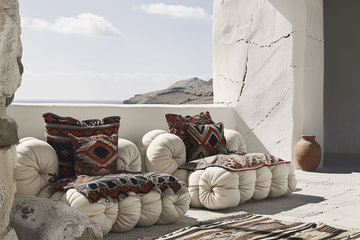
In the heart of Barcelona stands an exceptional building that is unique to the world: Casa Batlló, designed by renowned Art Nouveau architect Antoni Gaudi. Snuggled in between an otherwise modern looking street, this building was home to the prestigious Batllo family, who hoped to increase their social status with their new, exceptional residence.
Although originally built in 1877, the building was classical, with no distinguishing characteristics. It was not a particularly desirable address either, except for its location in the centre of the city. Prominent textile merchant, Josep Batlló, purchased the property in 1900 and hired Gaudi to transform it in 1904. By 1906, Gaudi had delivered what many consider his masterpiece, and the Casa Batlló at last graced the city of Barcelona.
A Riot Of Colourful Mosaic
From the outside, the first thing people notice is the amazing array of colours that seemingly swim across the façade. Made up of mosaic pieces in shades of blue and green, the building looks like something out of the sea, complete with golden sunbeams shimmering on the surface. The curves of the balconies and windowsills add to the illusion of a moving ocean, with some even looking like seashells.

The shape of a basic cylinder, the building is topped with a unique roof that curves like a perfect wave to crown the tower. Constructed from a special type of ceramic from Mallorca, its electric blue colour catches the eye from miles away. Some have compared the glittering tiles to a dragon’s scales. Just behind the dragon’s back are four chimneystacks, covered in colourful tiles and curved in fluid lines. Topping the roof is a tower, giving the building its majestic castle feel.
An Ingenious Interior
Upon entering the grand house, a large, oak wood staircase poetically weaves up to each floor, culminating in the stunning ceiling. As you look up, you see the fluidity of the painted walls, which alternate from blues to greys, speckled with touches of gold and copper. Natural light flows down through a magnificent skylight, highlighting as the sun’s rays change positions the ceramic tiles, the walls or the ceiling.

A second staircase leads to the living quarters of the home and is situated around the elevator. The stairs change colours from white, pearl grey and blue at the lower levels, to bright blue and gold at the upper levels. The doors of the rooms in the living area are all constructed from oak and feature unique carvings.

Once you reach the top of the spiral staircase, you get to the loft, which is pure white. The area was mainly used to wash and hang clothes to dry, and also for storage. It overlooks a lovely terrace and features a small hallway. As you walk underneath the wavy roof, the area is spacious and leads to a small balcony.
Another section of the loft houses water reserve tanks. A hallway of glorious arches that mimic an animal’s ribcage, one cannot but admire the genius of Gaudi, who capitalised on the natural lighting and ventilation, with beautifully crafted windows lining the area that overlooks a courtyard.
To the left of the ornate wooden balustrade staircase, a metal column covered by two metal lace structures spiral upwards toward a glass ball crowned with claws. The area is divided into two sections. The first consists of rooms that make up the façade and a main living room, which was dedicated to prayers before being demolished. The second features private rooms that overlook the street through stained glass windows.
About Antoni Gaudi
Born in Catalan Spain in 1852, Antoni Gaudi suffered from rheumatism as a child and could not be as active as the other children his age. As a result, he became more observant of the nature around him, absorbing the lines and angles of everything he saw. He was faithful to the basic laws of engineering, but his innovative vision inspired him to create a new approach to architecture. He was influenced by art from the Orient, India, Persia, Japan as well as the Neo-Gothic style, eventually becoming the founding father of modernism, or Art Nouveau. He never married, dedicating his life to his work, which can be seen on all corners of Barcelona. He died in June 1926 at the age of 73, after being hit by a tram as he walked to perform his daily prayers.

















